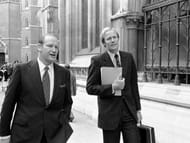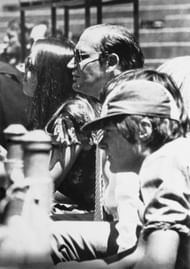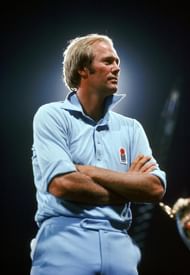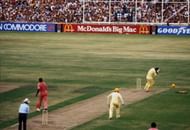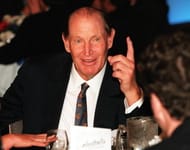Some days ago, the Pakistan Cricket Board suggested the concept of a day-night Test match to their Sri Lankan counterparts. The Australian Cricket Board will be trialling day-night first class matches this season to check out the possibilities of playing a Test under lights in a couple of years from now. The ICC has already okayed the proposal for Test-playing nations to explore the idea provided it is mutually agreed upon by both parties. A pink ball would be used; possibly even coloured clothing.
It may also be noted that it’s nearly thirteen years since the last limited-overs match at international level was played in whites.
If we were to go back in time to 1973 and tell someone about the happenings of 2013, we would be scoffed at, if not ridiculed outright.
At that time, cricket meant Test cricket, and one day cricket, which had just started to spread its wings, was treated as a pariah – a vehicle to capture the reducing attention span of the working class English cricket fan.
Test cricket was pure and pristine – to be preferably pursued as an amateur hobby rather than a profession, although the divide had been bridged some 20 years earlier. Commercialization of the game was totally un-English. And it took a die-hard Fosters-guzzling filthy rich Australian playboy to do it – and mostly by accident.
When his father Sir Frank passed away in 1974, Kerry Packer was put in charge of Channel Nine, one of the many media interests held by his family. Nine’s ratings had been down in the dumps for quite some time and Packer’s strategy was to get more sports programming on the network to target the sport-crazy Aussie. After securing the rights to the Australian Open (golf), Packer’s next target was cricket, which was regaining its popularity in the country thanks to the resurgence of the Australian team.
Till that point of time, cricket in Australia was broadcast by the government-owned ABC (Australian Broadcasting Corporation), simply because no one else felt it was worth broadcasting. Packer made a bid of AU$1.5 million to the Australian Cricket Board (ACB) which was worth 8 times the existing bid. In response, the ACB awarded the contract to ABC for a marginally increased sum of AU$210,000.
Packer was incensed, but he had no plans to give up. He approached the Test and County Cricket Board (TCCB) of England for the broadcast rights to Australia’s tour of England in 1977 with the same AU$1.5 million he hadn’t got an opportunity to spend.
The ACB though were determined to not let Packer come on board and suggested to the TCCB that they offer ABC’s contract for AU$210,000. Undeterred, Packer simply doubled his offer, which was accepted promptly. But he would never forget this incident.
Around the same time, a couple of West Australian businessmen, John Cornell and Austin Robertson, had an idea which they proposed to Packer – to play some televised exhibition matches, possibly with some of the recently retired players from the game. Packer had an even more audacious vision – he saw this as an opportunity to host a full series between the Australian team and the best players from the rest of the world.
To give this vision some direction, he brought on board the recently retired Ian Chappell and the then England captain Tony Greig to approach Australian players and other players around the world respectively. Everything was hush-hush; in close to three months, about 25 players had come on board for money or out of plain and simple dissatisfaction.
The news was leaked a couple of months later when the Australian team arrived to tour England. 13 of the 17 Australians on tour had committed to Packer and, as expected, all hell broke loose on the disclosure of the same. Greig came in for some special criticism for playing the role he did despite being an active cricketer. He was immediately stripped of his captaincy, although he did manage to keep his place in the team.
The English media supported their Australian counterparts in labelling the entire event as the “Packer circus” and portraying it as an object of ridicule. The Australian dressing room was divided, with the management threatening the Packer signees with life bans if they did not revert on their original decision. Not surprisingly, a dispirited Australian team surrendered the Ashes 3-0.
Packer though was far from done. In late May 1977, he reached England in a last-ditch attempt at reconciliation with the ACB. On his side this time was Richie Benaud as a consultant-cum-politicist.
The issue had by now gone from a mere Australian domestic problem to one which could threaten the entire cricketing world, and hence the International Cricket Conference (ICC) felt inclined to step in. A team from the ICC met Packer and Benaud at Lord’s on the 23rd of June to discuss the issue.
It took them 90 minutes to reach a common consensus, only for Packer to demand exclusive rights to Australian cricket after the ’78-’79 season ended. This was outside the ICC’s ambit and Packer stormed out of the meeting room but not before declaring war. “Had I got those TV rights, I was prepared to withdraw from the scene and leave the running of cricket to the board. I will take no steps now to help anyone. It’s every man for himself and the devil take the hindmost”, he thundered.
The ICC retaliated by deciding not to award first-class status to Packer’s matches as well as banning the players involved from Test and first-class cricket. The players themselves were shaken as, till that point of time, they had seen Packer the philanthropist, and now all they could see was Packer the businessman. A number of players now considered withdrawal as a serious option.
Responding to this, Packer had three of his players – Greig, the South African all-rounder Mike Proctor and the English fast bowler John Snow – file a petition in High Court to prevent a third party from influencing the players to break their contracts. The third party, in this case, was the ICC.
ICC’s counsel reasoned that if the top players left cricket to join Packer, the gate receipts at international matches would decrease. As expected, Justice Christopher Slade found this little more than amusing and he judged that the ICC was merely trying to protect its own interest at the expense of the players’ personal choices, and that the concept of loyalty might have been stretched too far.
Still, Packer could not use the term “Test Match” or call his team “Australia”, or use the official rules of cricket, as all of these were copyrighted to the MCC.
Everyone, except the ICC and the ACB, was notably pleased at this verdict as the players could have the best of both worlds and their parent clubs could still retain their services for first-class cricket.
Benaud started framing the rules for this series which would consist of five “SuperTests” played by the “World Series Cricket Australian XI”.
Packer was well and truly on his way; the only headache for him now was finding a suitable playground for his “big boys” in a very short time, since the ACB had shut the WSC out of its traditional cricket venues.
Never one to give up, Packer leased the VFL Park in Melbourne and Football Park in Adelaide (Australian Rules football stadiums), the Gloucester Park in Perth (a harness racing course) and the Moore Park in Sydney, which till then had been used for the Royal Easter Show.
None of these places even remotely resembled a cricket pitch, and to prepare proper pitches there in such a short span of time was well nigh impossible.
The ACB secretly sniggered, only to find out that Packer had wooed away one of their own into making this seemingly impossible task possible.
That person was the genius John Maley, the curator of the Gabba, who figured out that pitches could be grown into hothouses outside the venues and then air-dropped on the actual playing surface. A task, which should have taken several weeks and possibly months, was completed in a matter of days.
The first game of the WSC began at VFL Park on the 2nd of December between the Australians and the World team. It would have been more appropriate to call it a West Indian team though, considering the fact that all of the players were just that.
The possibility of earning more in a season than they could in an entire career had made an entire contingent from the Caribbean sign up – a pleasant, but nevertheless unexpected surprise for Packer, who later went on to launch a full-fledged West Indian team alongside the Australian and World teams.
The Australian cricket public, however, preferred to watch a weaker Australian national team battle it out with India at Brisbane, and a seating capacity of close to 80,000 at the Packer grounds accentuated the emptiness. The ACB had won the first round.
But then, WSC was not just cricket – it was supposed to be entertainment derived from gladiatorial combat. The marketing team tried to emphasise the same by heavily promoting the likes of Imran Khan, Dennis Lillee, Michael Holding and Andy Roberts.
The new pitches behaved more often than not as new pitches are supposed to, and things came to a head when David Hookes was felled by a crushing bouncer from Andy Roberts. Hookes’s broken jaw not only stood up as a legitimate emblem of WSC’s intensity, but also as an ironic memory 27 years later, when another punch to the jaw by a bouncer – this time a person – felled him to the pavement and led to his unfortunate death.
Hookes’s injury had other batsmen running for cover, quite literally. Dennis Amiss got a motorcycle mechanic to develop a customised helmet for him, replete with visor, which could handle the fast bowlers’ thunderbolts as well as a shotgun to the head (more about it here).
Others followed suit, and in the next couple of years, almost all cricketers at international level were wearing some form of protective equipment or the other.
The ACB though had pulled off a masterstroke by appointing the highly popular 41-year-old Bobby Simpson as the captain of the Australian team, where the only other known face was Jeff Thomson whose existing binding agreement with a radio station to play for Queensland came in his way to play World Series Cricket.
The Indian team of the time was also not the greatest, and two weak teams made for close matches. The final match was a decider which Australia won to grab the series 3-2. Big crowds attended all the matches, which had excellent media coverage.
In contrast, Packer was seen counting the number of cars at some of his matches. And yet, he still had one last glimmer of hope.
Understanding the entertainment quotient of limited overs matches, Packer placed greater emphasis on them than had ever been given before in Australia.
Alongside the SuperTests, he organised the “International Cup”, a one-day series between the three participating teams. This was the first time cricket was played under lights at night, and it did garner some amount of attention, although it was nothing significant. Packer had one foot in the door, and little did the ACB know that he was going to force his way through.
The biggest problem for the ACB was the stand taken by the other ICC countries. Most of the English counties were more than happy to keep Packer’s boys on their rolls, and the severely cash-crunched West Indian board was only too happy to let their men play for Packer.
Similarly, South Africa was very keen to lets its cricketers play in the “Big League” and prove that they were among the best in the world, if not the best. The son of the head of New Zealand Cricket himself was turning out for WSC.
Pakistan adopted a hardline approach, but relented when Packer signed on more Pakistanis after the first season. India was away from the humdrum of it all – they had still not become a cricketing superpower, and although some of their players (Sunil Gavaskar and Bishan Singh Bedi) were greats in their own terms, they did not fit in with the razzmatazz of the WSC.
Packer spent the off-season planning tours to New Zealand and West Indies and recruiting more overseas players. At one point of time, rumours started doing the rounds that the next season could see full-fledged English and Pakistani teams as well.
Another masterstroke that worked for Packer was the borrowed “Cavaliers” concept. In the 1960s, an ad hoc team of famous cricketers, titled “The International Cavaliers”, started touring venues that rarely saw big games in order to promote the game.
Packer used the same idea to plan a tour which would cover the provincial centres from Queensland to Tasmania, and which would feature recently retired cricketers and bright upstarts playing regularly for and against each other.
So you had the likes of Eddie Barlow, Ian Redpath, David Holford and Rohan Kanhai playing with the likes of Trevor Chappell and Kepler Wessels, who would go on to play for Australia some years later. In this process, Packer signed up a number of young Australian cricketers, which made the ACB’s job even harder.
The last trick Packer pulled out of his multi-dimensional hat was exercising his political clout to overturn the WSC ban at the Sydney Cricket Ground and at the Gabba. Not only that, he also got the New South Wales government to reimburse the bill for the light towers installed for his use at the SCG!
Packer also got the clearance to go ahead and use the Adelaide Oval, but he refused. Perth and Adelaide were off the agenda for the second season – his new strategy now was to focus on the traditional homes of Australian cricket and extract his pound of flesh from the ACB the following season.
The second season started with a bang on the 28th of November, 1978 at the SCG – it was a match between the Australian and West Indian teams.
This was the first time cricket was played under lights on a traditional cricket ground and 45,000 fans turned up to see the spectacle. The ACB should have taken this as a premonition; instead, they put a greenhorn captain in the form of Graham Yallop in charge of the Australian national side to face England in the upcoming Ashes.
The result was a humbling defeat in Brisbane, the first of five, in what turned out to be a long home summer for the Australians.
The England side was more experienced and professional, and unfortunately for the ACB, very boring. Their way of establishing ascendancy was through playing slow cricket and putting their opposition through the grind.
This was in direct contrast to the more glitzy, marketing-savvy grindhouse experience of World Series Cricket. Attendances at the stadia fell and even the media deserted the ACB as it waited for the Australian side to return to full-strength.
The WSC, on the other hand, continued its merry juggernaut of night-time one day matches which pulled in crowds into the stadia as well as on television. Unlike the ACB, the WSC targeted women and children, and this segmentation worked wonders for them. Not to mention, the high standards of cricket helped a lot.
The SuperTest final between Australia and West Indies at the SCG, which was also the last WSC match on Australian soil, drew in a crowd of 40,000 over three days. At the same time, the ACB could hardly managed a cumulative crowd count of 20,000 over five days for the Ashes and the Pakistan summer after that. Eight Tests in a summer served no one any good – the players were tired and the board out of money.
The WSC then headed for the Caribbean and what followed was one of the best series of all time, even though it was unofficial. The series helped the West Indies Cricket Board to come back into financial solvency and added to WSC’s coffers too.
Back home, the ACB was struggling. The prolonged battle with Packer had exhausted all its resources – it seemed as if he had a bottomless pit full of Australian dollars. Truth be told, Packer himself was under the cosh – the losses of the first season had not yet been fully recovered.
So it must have come as a relief to both parties when, after several rounds of meetings, a truce was finally reached on 30th May, 1979.
Packer may have lost many of the battles but he had won the war – not only did Channel Nine get the broadcast rights, but Packer also bagged a contract to promote and market the game in Australia for the next ten years.
In effect, it meant that the Australian cricket schedule now mimicked that of the erstwhile WSC, with six Tests against two opposition sides each summer, and an ODI tri-series (not coincidentally called the World Series Cup) with the same opponents thrown in.
The format came under heavy criticism but made a lot of money, most of which went to Packer’s company. The WSC players came back to the fold a year later as the Australian selectors failed to find replacements for the struggling members of the team which went to the 1979 World Cup and the subsequent series in India.
Greg Chappell was reinstated as captain and everyone was happy again, except for the ICC and the TCCB, who had provided most of the support to the ACB through the tumultuous years of WSC, and now found themselves short sold for money.
WSC may have lasted for only two years but it left some very deep impressions on the game of cricket, and not all of them were controversial.
Many argue that the greatest effect WSC had on the game of cricket was coloured clothing, although they were used only in the latter part of the second season, and more as a gimmick than as a serious element of the setup. I find a few other things that make more sense in the modern day scenario.
a) Thanks to the gruelling schedules and frequent travelling, cricketers had to be fitter than ever before. This showed up on the field in the form of their fielding and catching, which was generally nothing short of brilliant.
b) Limited overs cricket saw an upsurge in popularity – so much so that about twenty years later, it spawned another variant in the form of Twenty20. The day-night format turned out to be a craze, especially for working professionals who now had a reason to head back home directly after work.
c) Playing cricket is now a full-time profession even in some of the Associate countries – some of their players like Ryan ten Doeschate are regular county cricketers and have found more employment in the various Twenty20 leagues around the world. The money involved in the game now is of significant proportions too.
d) Broadcasters now have a greater say in the running of the game. This is sometimes unfortunate as in the case of the West Indies-Sri Lanka Test series which had to give way to an ODI tri-series involving the more “profitable” India.
e) Test cricket saw itself being threatened by its younger brothers and hence nowadays we see a lot more innovation in the game. The DRS and Hotspot may be controversial, but they certainly provide a zing to the otherwise staid nature of the game. Players themselves have become more adaptive, and today we see more results in the longest format than ever before.
f) The marketing of the game itself changed – for the first time we got to know about something called cricketing merchandise. It is one of the biggest sources of revenue for the game today.
Zee TV’s Subhash Chandra tried a ‘Packer’ of his own with the Indian Cricket League after Zee Sports lost the rights to India’s cricketing season to Neo Sports. While he wasn’t half as successful as Packer, he did initiate a chain reaction which started with the Indian Premier League and has now spawned many variants over the world.
Clearly, this suggests that the game of cricket lends itself to change. You only need the will of a Packer to implement it.
Read more about such events which altered the way cricket was played over the years – The moments that changed cricket forever.
Brand-new app in a brand-new avatar! Download Cric Rocket for fast cricket scores, rocket flicks, super notifications and much more!
